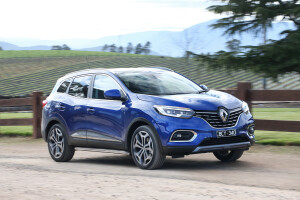Latest Review
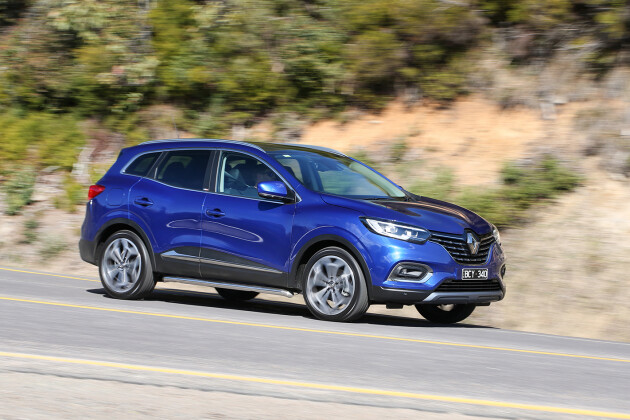
2020 Renault Kadjar review
Everything you need about the Renault Kadjar small SUV including pricing, features, safety and comfort.
What stands out?
The Renault Kadjar bridges the size gap between the French car-maker's Captur and Koleos SUVs. It shares a chassis with the Nissan Qashqai, but is more attractively styled inside and out and powered by a 1.3-litre turbocharged petrol engine built by Mercedes-Benz that drives the front wheels only.
It is comfortable and well-equipped, with Android Auto/Apple CarPlay smartphone pairing and autonomous emergency braking standard across the range.
What might bug me?
Easing back in bends because of the light steering that’s great around down but can feel disconnected from the front wheels at higher speeds.
Getting tired of so-called friends pointing out your fancy ‘French SUV’ shares underpinnings with the Nissan Qashqai, is built in Spain, and has a Mercedes-Benz engine.
Having to bring your face closer to 7.0-inch touchscreen to view the tiny reversing camera display.
What body styles are there?
Five-door wagon only.
The Kadjar is classified as a medium SUV, lower priced.
What features do all Kadjar versions have?
Dual-zone climate control, which allows the driver and front passenger set their own preferred temperatures.
Renault’s R-Link 2 multimedia system, with 7.0-inch touchscreen, voice control, Apple CarPlay/Android Auto phone mirroring, AM/FM radio, auxiliary and 2x USB inputs, Bluetooth connectivity for phone calls and audio streaming, and seven speakers.
A reversing camera, and front and rear parking sensors.
Cruise control with speed limiter, and high-resolution digital gauge display.
Headlights that switch themselves on when it gets dark, LED daytime running lights, and LED rear fog-lamps. Windscreen wipers that operate automatically when it rains.
Hill-start assist, which operates the brakes automatically to make uphill starts easier.
Aluminium alloy wheels, and space-saver spare wheel.
Forward collision warning system (autonomous emergency braking), which warns of a potential collision risk before automatically engaging the brakes via the Koleos’ electronic stability control.
Tyre-pressure monitor, and power-folding door mirrors.
Shark-fin antenna, electronic park brake, rear privacy glass, and ambient interior lighting.
Every Renault Kadjar carries a five-year, unlimited kilometre warranty.
Which engine uses least fuel, and why wouldn't I choose it?
The Kadjar has one engine choice, a 1.3 litre, four-cylinder turbocharged petrol engine sourced from Mercedes-Benz. This is the same as the one found under the bonnet of Mercedes-Benz A200, but with a slightly different tune.
This engine meets strict Euro6 emissions standards and has a frugal official combined fuel consumption rating of 6.3L/100km, though it does require pricier RON 95 premium unleaded petrol.
As in the A200, it’s coupled to a seven-speed dual-clutch automatic transmission, though this is a Renault gearbox that’s also found in the Renault-built Alpine A110 sports car. Throttle response is almost instant, unlike in the Mercedes-Benz A200, which experiences considerable lag when you put your foot down.
All Renault Kadjar versions are front wheel drive.
What key features do I get if I spend more?
The least costly Kadjar is the Life which has cloth seat trim, 17-inch alloy wheels plus the features found in any Kadjar.
Paying more for a Kadjar Zen brings you push-button start, satellite navigation, and you can customise your infotainment home screens.
You also gain front fog-lights that point into a corner as you turn, and side parking sensors that augment those at the front and rear.
Seats trimmed with artificial leather bolsters and premium quilted fabric inserts, and the driver’s seat lumbar support.
Two USB sockets, heating and cooling vents for rear-seat passengers, and one-touch fold down rear-seats.
Doors that automatically lock when you walk away from the car while carrying a proximity key-card.
Blind-spot warning alerts you to any cars driving up your side, and lane-departure warning lets you know if you’re straying over the lines.
Roof rails, and auto-folding side mirrors with demisters.
A panoramic sunroof and auto-dimming rear-view mirror are available with the Zen as extra-cost options.
Spending more again on a Kadjar Intens brings you a BOSE sound system with digital amplifier.
Powered hands-free tailgate, chrome exterior trim, fancier 19-inch alloy wheels, and the panoramic sunroof as standard.
Automatic hands-free park assist that steers your Kadjar into parallel and 90-degree parking spaces. All you need to do is control the brakes.
Auto-dimming rear-view mirror, LED front and rear fog-lights, and automatic high/low beam.
Steering wheel and seats trimmed with artificial leather. The front seats are heated and have cushion extensions for more under-thigh support, and the driver’s seat has power adjustments.
Does any upgrade have a down side?
The ride is a little harder on the Intens’ 19-inch wheels, because their shorter sidewalls leave less air and rubber between you and the road.
Solid white is the only standard colour on the Life, Zen and Intens. Other colours cost about $900 extra.
How comfortable is the Kadjar?
The Kadjar has a roomy cabin for a small SUV and even tallish adults will find enough space in the second row, with plenty of head and knee room available. The front seats in the Zen and Intens have excellent side bolstering, with the latter’s cushion able to extend for additional under-thigh support. It offers an agreeable driving position with excellent forward vision.
The interior is elegantly designed and boasts a pronounced European flavour. The Zen’s cloth seat-backs and cushions have an attractive quilt pattern and are arguably more comfortable than the leather appointed seats in the Intens.
The interior is well put together, but we noticed the odd squeaking noise where the centre console meets the dashboard. This is likely just a new car thing and should go away once everything settles.
Then there’s that quirky Renault feature of having the cruise control/speed limiter toggle down on the centre console. This can make it difficult to find while driving at first, but you’ll soon get used to it. Same goes with the audio controls, which are on a paddle behind the steering wheel.
The infotainment system works well, though the 7.0-inch screen is a little small by current standards and it can be difficult to view the reversing camera display. The digital gauges on the other hand are nice and bright and you can choose between five different styles.
The Kadjar’s ride quality is very good. It glides over smooth roads and handles rougher surfaces well, with little secondary bounce. There is noticeable lean through bends though, which is mostly felt in the rear seats.
What about safety in a Kadjar?
Every Kadjar has stability control, six airbags, auto-on headlights, LED daytime running lights, a reversing camera, front and rear parking sensors and autonomous emergency braking. It is a rounded package that emphasises crash protection, visibility, crash avoidance, and safe reversing.
There are airbags ahead of the driver and front passenger to protect them in frontal crashes; one outside each front seat about chest level to protect in side-crashes; and a curtain airbag extending down each side at head level to protect those in the front and second seat rows from side crashes.
The front-row seats have seat-belt reminders, second-row seats have none.
The autonomous emergency braking (AEB) fitted to every Kadjar uses a radar-type sensor and operates at city and highway speeds. It works in concert with a Forward collision warning, which alerts you if it thinks you are too close to the vehicle in front. If you ignore the warning and the system concludes a crash is imminent, it can apply the brakes automatically, either avoiding the crash or reducing your impact speed. The AEB system will not detect pedestrians or cyclists.
The Kadjar Zen and Intens also have parking sensors, and a blind-spot warning, which alerts you to the presence of vehicles near your rear corners that might not show in your mirrors, and lane keeping assist, which warns of your lane-drift, and attempts to correct it.
The Renault Kadjar is yet to receive an Australasian New Car Assessment Program (ANCAP) safety rating, but the pre-facelift version sold overseas was awarded the maximum five stars by Euro NCAP in 2015.
I like driving - will I enjoy this car?
The Kadjar provides the kind of perky driving experience you expect from some of the smaller Renault models. The 1.3-litre turbocharged engine is small but provides enough power which makes this a fun car and comfortable car for longer drives.
It’s nimble for an SUV, with light and direct steering that makes it easy to park and drive through tight spots. However, the steering does feel disconnected from the front wheels at higher speeds, which saps confidence when negotiating winding roads. A Sport setting that hardens the steering feel would be a great addition.
The Kadjar otherwise handles surefootedly, both on and off paved roads: it shrugs off potholes and big lumps with ease, and handles its weight well in corners. The ride can feel a touch fidgety on smaller bumps and corrugations, particularly on the bigger diameter wheels, but otherwise it has a comfortable and capable suspension tune.
How is life in the rear seats?
There’s enough space for a couple of adults (or three kids). The Zen and Intens are separate air vents at the back of the centre console, and a pair of USB outlets and 12-volt socket to keep phones and tablets charged up. The Kadjar Life has just the 12-volt socket.
The rear doors have deep storage bins that will hold a 1.5-litre bottle, and there’s a fold-down centre armrest with two cupholders in the two upper-spec versions. The two outward seats feature ISOFIX child-seat anchor points.
The ride in the second row is generally smooth, and side vision is good, despite the Kadjar’s rising shoulder-line.
How is the Kadjar for carrying stuff?
The Kadjar has a 408-litre boot space, which is 22 litres less than the Nissan Qashqai on which it’s based. The 60:40 split seats can fold down instantly using catches in the boot space to extend cargo carrying capacity to 1478 litres.
Towing capacity is a handy 1500kg braked, which will let you tow a small- to medium-sized trailer.
Where does Renault make the Kadjar?
The Renault Kadjar is made in Spain.
What might I miss that similar cars have?
More advanced driver assistance features including active cruise control, as is standard in the Kia Seltos, Toyota C-HR and upper-spec versions of other rivals.
All-wheel-drive traction, as available in the Seltos, C-HR, Hyundai Kona, Mazda CX-3, and Subaru XV.
Other roomy small SUVs similar to the Kadjar include the Citroen C3 Aircross, Honda HR-V, and Mitsubishi ASX.
Then of course there’s its Nissan Qashqai cousin, which manages to provide more rear legroom and boot space, but not enough to make a noticeable difference. It also has better road holding through bends than the Kadjar, but both have comfortable rides even on rougher roads and are smooth, quiet and nimble ride around town.
All that said, the Kadjar feels like a newer generation car, with its stylish interior, more sophisticated and efficient 1.3-litre turbo/dual-clutch powertrain, and digital gauges combining with a superior infotainment system to make it a more compelling buy.
I like this car, but I can't choose which version. Can you help?
The Zen is the sweet spot in terms of pricing and equipment levels. It has plenty more features than the entry-level Life to justify the $3000 premium and drives a little better than the Intens on its smaller 17-inch wheels. And you won’t really miss the Intens’ extra features, though if you like the sunroof you can add it as an option for about $1000.
Are there plans to update this model soon?
The Renault Kadjar first went on sale in Europe in 2015 and received a mid-life update in 2019. It’s the updated version, with the more powerful 1.3-litre turbo engine that first appeared on the Australian market in November 2019 for the 2020 model year.
Don’t expect any model updates until at least 2021, though there may be special edition versions introduced from time to time.
Score breakdown
Things we like
- Cabin comfort, generous equipment list, smooth ride
Not so much
- Loose road holding, small infotainment screen
News
-
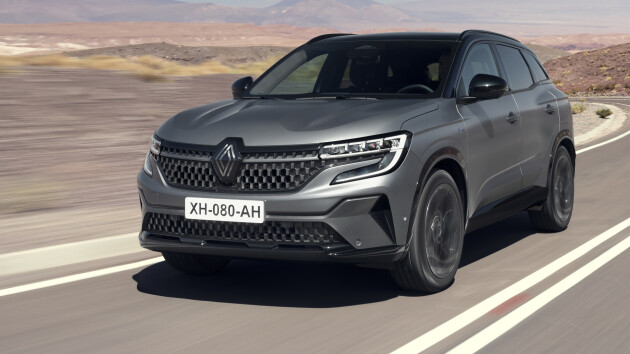 News
News2023 Renault Austral – everything we know
Tech from the fully-electric Megane will trickle into the Austral
-
 News
News2023 Renault Austral revealed, Australian debut not confirmed
The Kadjar is dead, long live the Austral – Renault's new-generation compact SUV
-
News
2023 Renault Austral name confirmed as Kadjar successor
Renault’s incoming SUV mid-sizer spotted
-
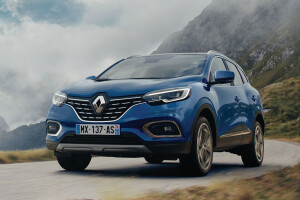 News
News2020 Renault Kadjar pricing and features
Renault's mid-sizer plugs the gap in in its local SUV range
-
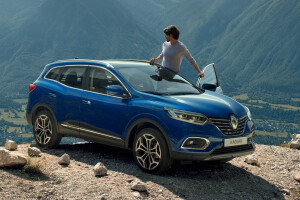
Renault Kadjar SUV confirmed for Australia
-
.jpg)
Renault Kadjar first official pics



